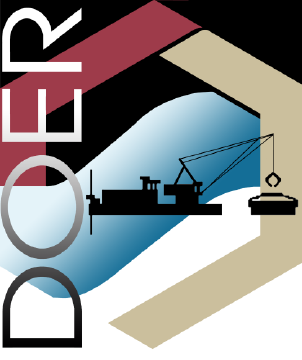Sequestering Dredged Sediment Contaminants for Beneficial Use Applications in 3D-Printed Structures
The U.S. Army Corps of Engineers has set an ambitious goal to beneficially use 70 percent of its dredged sediment by 2030. It’s a big challenge that will require innovative solutions for fine-grained dredged sediments that cannot be used for traditional applications, such as beach nourishment. Researchers at the U.S. Army Engineer Research and Development Center’s (ERDC) Environmental Laboratory are working to overcome these challenges as they develop methods for deploying dredged sediment as feeder stock in 3D printing.
Beyond the mechanical processes of using dredged sediment for 3D printing, ERDC researchers are also pioneering pre- and post-processing methods to help determine the material’s feasibility for being safely reintroduced into the environment. These printed structures will be used to enhance habitat, infrastructure, sediment containment, and energy dissipation, among other benefits. Little data on these processes currently exists and ERDC is looking to close that knowledge gap. Watch to learn more.
POC: Mark Ballentine (Mark.L.Ballentine@usace.army.mil)
Lake Altoona sees latest in U.S. Army Corps of Engineers sediment collecting testing
The U.S. Army Corps of Engineers sent teams from Saint Paul and Vicksburg, Mississippi Tuesday morning to install a smaller sediment collector to gather data on its effectiveness.
POC: Chuck Theiling (Ret.)
Dredging Evaluation Management, Analysis and Networked Documentation (DEMAND) Application Demo
The Dredging Evaluation Management, Analysis and Networked Documentation (DEMAND) Application is designed to guide a dredged material program manager, risk assessor or data generator through 103 or 404 dredging evaluations. The tool was produced through DOER project 19-11. DEMAND can be used for initial project planning and documentation as well as recording decisions made during the dredging evaluation process. The application provides step-by-step procedures for planning and executing a dredging evaluation (e.g., what and when to test) and document rationale for decisions and communication with stakeholders. The application is useful for stakeholder decision documentation so that the same conversations and decisions are not revisited. Installation instructions can be found in the Technical Report “Advances in Dredged Material Evaluations for Inland and Ocean Aquatic Placement: Modernized Processes and Supportive Tools”.
POC: Alan Kennedy (Alan.J.Kennedy@usace.army.mil)
Dredging Evaluation Visualization, Organization and Integration Database (DEVOID) Tool Demo
The Dredging Evaluation Visualization, Organization and Integration Database (DEVOID) tool is a data visualization application. The tool was produced through DOER project 19-11. The application mines a dredging database file represented within a Microsoft Excel spreadsheet. The DEVOID tool was written using the R programming language and packaged using the 7-Zip compression software. The DEVOID tool facilitates examination of historic information (e.g., prior dredging evaluations) to support the initial evaluation and management decisions prompted within the DEMAND tool. For the DEVOID tool to be valuable, its associated database must be populated with the most recent dredging evaluations of the location(s) of interest.
POC: Alan Kennedy (Alan.J.Kennedy@usace.army.mil)
DOER Research: Acoustic Camera Particle Image Velocimetry (PIV)
This project investigates the use of a 3D acoustic camera to acquire two-dimensional velocity vector fields from PIV analysis. An experiment was performed to quantify the two-dimensional velocity field of a simple laboratory flow using PIV with both 3D acoustic camera images and standard optical camera images, along with ADV transect measurements, to determine whether the acoustic camera PIV results are accurate. The success of this project will lead to an entirely new technique to measure flow velocities in turbid environments in the field, one that yields substantially more information than the technologies currently available (i.e., two-dimensional velocity vector fields) and allows velocity gradient based hydrodynamic signals to be directly estimated.
POC: Dr. David Young (David.L.Young@erdc.dren.mil) and Dr. Brian McFall (Brian.C.McFall@erdc.dren.mil)
Materials fabrication and dredging assessment scenarios using low-cost 3D printing applications
A customizable, fit-for-purpose monitoring technology resulting from this research will provide insight to down-select DM sites potentially needing remediation measures vs. areas where CoC bioavailability is of lesser concern. We will expand low cost 3D printing technology to be amenable to on-site, on-vessel, on-demand materials for remediation (adsorption, destruction) and monitoring to down select and reduce cost of analyzing traditional and emerging contaminants of concern and field deploy the technology to address scalability. USACE would realize cost savings by reducing: (1) imprudent evaluations; or (2) dredging to remove low risk materials.
POC: Alan Kennedy (Alan.J.Kennedy@usace.army.mil)
Animations
The animations presented here are general schematics of dredgeheads in operation under water. They are provided for educational use or for use in presentations, etc.
Video Gallery
The videos presented here show various aspects of a dredge operation. They are provided for educational use or for use in presentations, etc.
